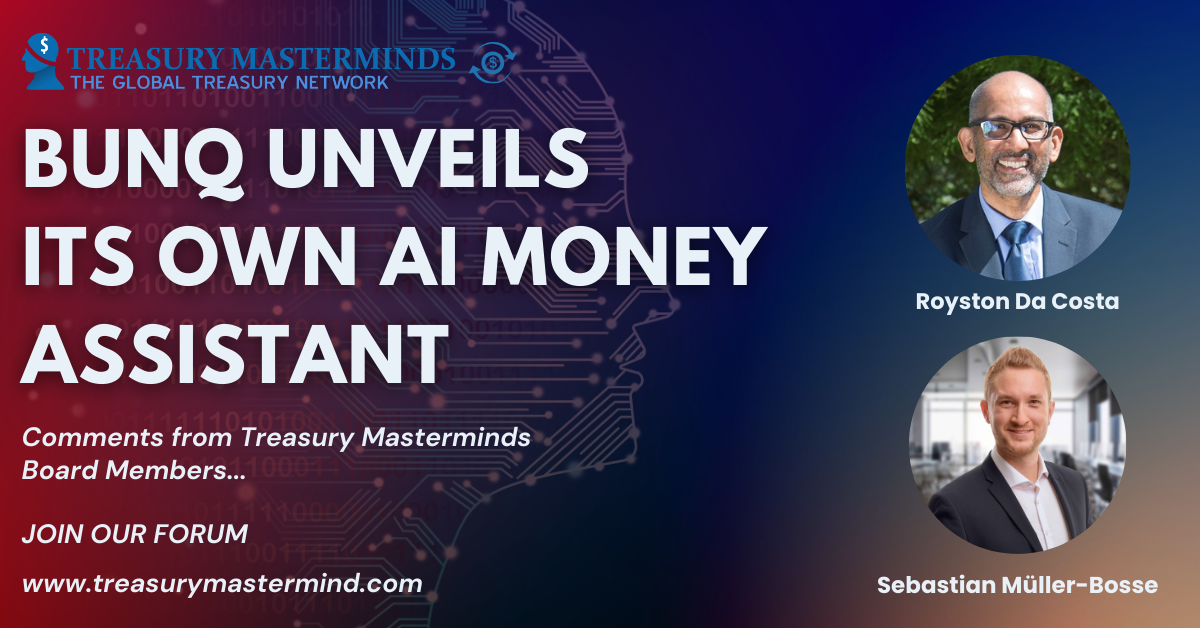
Bunq, a prominent European Neobank, has partnered with Mastercard to innovate in open banking by introducing a new generative AI platform named Finn. This move marks Bunq as the first AI-powered bank in Europe, showcasing its commitment to leveraging advanced technologies for enhanced user experiences. To learn more about Bunq AI Finn, check [HERE].
Recommended Reading
- Reuters FED Interest Expectations
- SWIFT AI in Fraud Check
- AI Tools and Platforms for Financial Analysis
- Visa Expands Digital Wallet Capabilities with Seven Key Payment Innovations
- CNBC article discusses the growing concerns about the United States
- Are You Developing Skills That Won’t Be Automated?
Key Features of Finn
1. Generative AI Integration
Finn replaces the traditional search function within the Bunq app, offering users a chat-style interface where they can ask questions about their finances. This integration allows for more personalized and efficient management of financial activities.
2. Advanced Query Handling
Users can inquire about detailed aspects of their spending and savings. For example, Finn can answer questions such as “What is the average amount I spend on groceries per month?” or “How much did I spend on Amazon this year?” It can also provide contextual answers, such as identifying a specific restaurant visit or the amount spent at a particular location on a given day.
3. User-Centric Approach
The platform is designed to enhance user convenience, allowing them to manage their finances seamlessly. According to Bunq’s founder and CEO, Ali Niknam, the goal is to make banking more intuitive and aligned with users’ lifestyles through the use of cutting-edge AI technology.
Impact on Bunq’s Growth
The introduction of Finn is part of Bunq’s broader strategy to expand and innovate. Neobank has seen significant growth, now boasting 11 million users across Europe. Since July 2023, user deposits have increased by 55%, reaching 7 billion euros. This growth is attributed in part to the successful integration of AI, which has helped Bunq attract and retain a larger user base.

Additional Features and Services
1. Free Credit Cards
Bunq now offers free credit cards that can be set up in just five minutes and used immediately through Apple Pay or Google Pay. This service aims to provide greater financial flexibility and convenience for users.
2. Tap to Pay
Leveraging Apple’s Tap to Pay technology, Bunq allows business users to turn their iPhones into payment terminals, facilitating on-the-go payment acceptance. This feature is available to all Bunq users at no extra cost, further enhancing the app’s functionality.
Strategic Significance
The partnership with Mastercard and the launch of Finn underscore Bunq’s ambition to redefine banking through technology. By focusing on AI-driven solutions, Bunq aims to set a new standard in the neobanking sector, emphasizing user-centric innovation and international expansion. This strategic move aligns Bunq with tech giants like Google and Amazon, which are also at the forefront of AI development.
In summary, Bunq’s introduction of the Finn AI platform in partnership with Mastercard represents a significant advancement in open banking, highlighting the bank’s commitment to innovation, user convenience, and rapid growth in the European market.
Insights from Treasury Experts
We thought it would be valuable to get perspectives from a Treasury professionals, Royston DaCosta and Sebastian Muller Bosse, who is also a Treasury masterminds board members
Q: What do you think of this, Royston and Sebastian? What does this mean for the future of banks/banking?

Royston Da Costa, Assistant Treasurer at Ferguson PLC, Comments
Excellent innovation-this will be the future for at least retail banking! There is still the caveat, in my mind, that AI is not perfect yet and all data/answers must be vetted or handled with some care. Of course, the game changer is when corporations are able to take advantage of this functionality.
I believe “Finn’s” advanced query handling functionality is already available with some FinTech/Banks but I agree with the idea that it should be more widely available.
A great way for the app to be user-centric is it could for example, analyse your monthly spend and automatically invest your surplus cash for the days its not required, to maximise the interest you earn on your cash balances?
It makes sense (that Finn is part of Bunq’s broader strategy to expand and innovate), although caution should still be applied, i.e., we would not wish to experience a repeat of SVB, i.e., ensure you invest up to the limit covered by the Central Bank and diversify your investments with multiple counterparties.
Bunq’s free credit card offering sounds great but is this too good to be true, i.e., what sort of limits are offered and/or is everyone really eligible? Although, its Tap to Pay technology is not farfetched, because it has become the standard method of payment for the current generation!
Bunq’s partnership with Mastercard and the launch of Finn underscore its ambition to redefine banking through technology but Bunq does not have the financial power that Google and Amazon hold!
In conclusion, I believe Bunq’s AI money assistant is a positive step and will enhance value for consumers (and hopefully for corporations soon). Banks/banking will have to seriously ratchet up their game if they wish to keep up with this innovation!
It is interesting to me that I am seeing a two tier race developing, i.e., Fintechs/Banks investing and developing technology that is ‘future proofed’ vs. mainly banks that either refuse or are not willing to invest in technology and WILL lose customers as a result. Furthermore, the banks that are not willing to upgrade their technology will find it increasingly difficult to adapt to new regulations as they arise.

Sebastian Muller Bosse, Manager Administration & Operations at Finance & Treasury Services GmBH, Comments
The feature to look at your overall spending, search for specific transactions , and transactions being automatically categorized by a banking app isn’t necessarily new to retail customers. The ability to ask questions directly rather than just looking at default graphs, exporting data and making own calculations is of course a much more convenient way and will ease the use of adoption (especially for the older generations!). For innovators and early adopters these AI features will likely be a reason to try it out and to expect these kind of features in future. For the late majority and laggards it could feel more like a “gamification” of the search functionality that is nice to have but not a reason to switch their bank. I think it will help users that are already doing spending analysis on a regular basis a lot. Users who are rarely doing these kind of spend analysis might use it more since it’s so simple and handy.
The goal to make banking more intuitive will be definitely achieved by integrating this AI feature and get contextual answers rather than just graphs and tables. This step would also bring corporate treasurers enormous value, since spend & liquidity analysis is their daily business. Today hours are spend by just collecting and cleaning the data and creating the graphs and tables (i.e. liquidity plans / cash flow forecasts). The actual data analysis is what brings value and insights. If this could be done by AI that tells you WHY there is a gap / decrease / increase in cash, treasurers would be really happy. TMS vendors can take this feature as an example from these fintechs and would be well advised to integrate / embed such AI features in their solutions as well. Every feature that reduces manual steps, shortens the overall process, and eases usability brings automatically value to the table.
Join our Treasury Community
Treasury Mastermind is a community of professionals working in treasury management or those interested in learning more about various topics related to treasury management, including cash management, foreign exchange management, and payments. To register and connect with Treasury professionals, click [HERE] or fill out the form below to get more information.